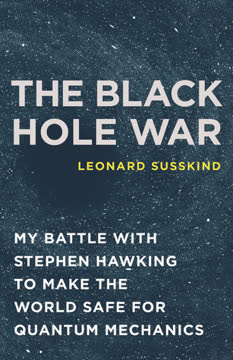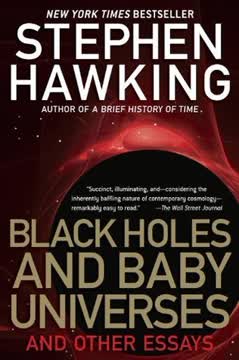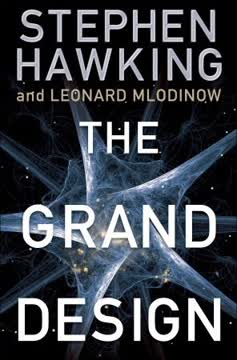Key Takeaways
1. Stephen Hawking's resilience transformed his disability into scientific focus
"It inspired him to value each of his remaining days."
Diagnosis as catalyst. In 1963, at age 21, Stephen Hawking was diagnosed with amyotrophic lateral sclerosis (ALS), a progressive neurodegenerative disease. Given only a few years to live, this devastating news initially plunged Hawking into depression. However, he emerged from this dark period with a renewed sense of purpose and urgency in his scientific pursuits.
Adapting to limitations. As his physical abilities declined, Hawking developed innovative ways to conduct his research:
- Relied on mental visualization and geometric thinking instead of writing equations
- Developed a sophisticated nonverbal communication system
- Embraced more speculative and less mathematically rigorous approaches to physics
Defying expectations. Despite his prognosis, Hawking lived with ALS for over 50 years, making groundbreaking contributions to physics and becoming a global scientific icon. His resilience in the face of adversity inspired millions and demonstrated the power of the human spirit to overcome seemingly insurmountable obstacles.
2. Hawking radiation: A groundbreaking fusion of quantum theory and general relativity
"What Stephen discovered was that you couldn't ignore it, that quantum theory changed things in an essential way."
Paradigm shift. In 1974, Hawking proposed that black holes are not entirely "black" but emit a form of radiation, now known as Hawking radiation. This discovery was revolutionary because it:
- Combined principles from both quantum mechanics and general relativity
- Challenged the prevailing notion that nothing could escape a black hole
- Suggested that black holes could eventually evaporate and disappear
Theoretical implications. Hawking radiation had profound consequences for our understanding of black holes and the universe:
- Introduced the concept of black hole thermodynamics
- Raised questions about the conservation of information in physics
- Sparked decades of research into quantum gravity and the nature of space-time
Scientific recognition. While Hawking never received a Nobel Prize for this work (partly due to the lack of observational evidence), Hawking radiation is widely accepted in the physics community and remains one of his most significant contributions to science.
3. The no-boundary proposal: Reimagining the origin of the universe
"His answer was a surprising one—that there was, in the sense I've explained, no beginning, because time had turned into space."
Quantum cosmology. In the 1980s, Hawking and James Hartle developed the no-boundary proposal, a quantum theory of the universe's origin that challenged traditional notions of the Big Bang. Key aspects of this theory include:
- The universe has no definite starting point or "boundary" in time
- Time becomes indistinguishable from space in the early universe
- The universe's history is determined by quantum probabilities rather than a single, definite past
Philosophical implications. The no-boundary proposal had far-reaching consequences for our understanding of existence:
- Eliminated the need for a singular moment of creation
- Questioned the role of a creator or "first cause" in the universe's origin
- Suggested that asking what came "before" the universe may be meaningless
Ongoing research. While the no-boundary proposal remains speculative, it has inspired numerous theoretical investigations into the quantum nature of the early universe and continues to influence cosmological research.
4. A Brief History of Time: Catapulting physics into popular culture
"Worldwide it has now sold well over ten million copies."
Unexpected bestseller. Published in 1988, "A Brief History of Time" brought complex scientific concepts to a general audience, becoming a cultural phenomenon:
- Simplified explanations of cosmology, general relativity, and quantum mechanics
- Addressed profound questions about the nature of the universe and our place in it
- Remained on bestseller lists for an unprecedented 237 weeks
Impact on science communication. The book's success:
- Demonstrated a widespread public appetite for complex scientific ideas
- Inspired a new generation of popular science books and authors
- Elevated Hawking to the status of a global scientific celebrity
Financial implications. The book's success provided Hawking with the financial means to support his increasing medical needs and continue his research. It also led to numerous speaking engagements, television appearances, and even cameos in popular media, further solidifying Hawking's status as a cultural icon.
5. Hawking's evolving views on black hole information paradox
"He had decided he was wrong on an important matter and was reversing his position."
The paradox. Hawking's work on black hole radiation led to a fundamental conflict in physics:
- Quantum mechanics requires information to be preserved
- Hawking's initial calculations suggested information is lost in black holes
- This contradiction became known as the black hole information paradox
Changing perspective. Over decades, Hawking's stance on this issue evolved:
- Initially argued that information is truly lost in black holes
- Made a famous bet with John Preskill in 1997, claiming information loss
- In 2004, dramatically reversed his position, conceding the bet
Ongoing debate. While Hawking's change of heart was significant, the information paradox remains unresolved:
- Most physicists now believe information is preserved, but the mechanism is unclear
- Hawking's final paper, published posthumously, continued to explore this problem
- The paradox continues to drive research in quantum gravity and fundamental physics
6. The Grand Design: Exploring the multiverse and the fine-tuning of the universe
"There seemed to be only two ways to understand the presence of such a delicate balance of particles, forces, and laws."
Fine-tuning problem. "The Grand Design" addressed the observation that the universe appears precisely calibrated to allow for the existence of life:
- Slight changes in fundamental constants could prevent the formation of stars, atoms, or complex structures
- This apparent fine-tuning has been used as an argument for the existence of a creator
Multiverse solution. Hawking and co-author Leonard Mlodinow proposed an alternative explanation:
- Our universe may be one of many in a vast multiverse
- Each universe in the multiverse has different physical laws and constants
- We naturally find ourselves in a universe compatible with our existence
Philosophical implications. This approach:
- Challenges traditional notions of cosmic design or purpose
- Suggests that the apparent fine-tuning of our universe is a selection effect rather than evidence of intentional creation
- Raises questions about the nature of scientific explanation and the limits of our ability to understand the cosmos
7. Hawking's personal life: Balancing love, fame, and scientific pursuits
"Love is life," he said.
Relationships and caregiving. Despite his physical limitations, Hawking maintained deep personal connections:
- Married twice: to Jane Wilde (1965-1995) and Elaine Mason (1995-2006)
- Faced challenges in balancing his scientific work with family life
- Relied on a team of dedicated caregivers, developing close bonds with many
Public figure. Hawking's fame brought both opportunities and challenges:
- Became a global ambassador for science and disability rights
- Struggled with the demands of celebrity and media attention
- Used his platform to advocate for scientific funding and public engagement
Personal resilience. Throughout his life, Hawking maintained a sense of humor and zest for life:
- Enjoyed travel, parties, and social interactions despite physical limitations
- Continued to work on physics problems until his final days
- Inspired millions with his courage and determination in the face of adversity
8. Top-down cosmology: A new approach to understanding the universe's evolution
"To calculate the probability that the universe now has this property or that, he had to add up contributions from all possible ways the universe might have evolved."
Quantum history. Hawking's top-down cosmology, developed in the early 2000s, applied quantum principles to the entire universe:
- Considered all possible histories of the universe, not just a single timeline
- Used Richard Feynman's "sum over histories" approach on a cosmic scale
- Aimed to calculate probabilities for large-scale properties of the universe
Philosophical shift. This approach represented a fundamental change in thinking about cosmic evolution:
- Challenged the traditional "bottom-up" view of the universe's development
- Suggested that the present state of the universe influences its past, not just vice versa
- Aligned with Hawking's earlier no-boundary proposal in eliminating a definite cosmic beginning
Ongoing research. While highly speculative, top-down cosmology continues to inspire theoretical investigations:
- Offers a new perspective on the arrow of time and causality in the universe
- Provides a framework for addressing questions about cosmic initial conditions
- Represents Hawking's final major contribution to theoretical cosmology
Last updated:
FAQ
What is "Stephen Hawking: A Memoir of Friendship and Physics" by Leonard Mlodinow about?
- Personal and Professional Memoir: The book is a blend of memoir and scientific exploration, chronicling Leonard Mlodinow’s friendship and collaboration with Stephen Hawking over nearly two decades.
- Behind-the-Scenes Look: It offers an intimate look at Hawking’s personality, daily life, and the challenges he faced due to ALS, as well as his approach to science and relationships.
- Physics and Philosophy: The narrative weaves together stories of their work on books like "A Briefer History of Time" and "The Grand Design," while explaining complex physics concepts in accessible language.
- Humanizing a Genius: Mlodinow aims to show Hawking not just as a scientific icon, but as a deeply human, humorous, and resilient individual.
Why should I read "Stephen Hawking: A Memoir of Friendship and Physics" by Leonard Mlodinow?
- Unique Perspective: The author provides a rare, firsthand account of working closely with one of the most famous scientists of our time, revealing Hawking’s character beyond his public persona.
- Accessible Science: Mlodinow explains advanced physics concepts—like black holes, quantum theory, and cosmology—in a way that is engaging and understandable for non-experts.
- Inspiration and Resilience: The book is a testament to overcoming adversity, showing how Hawking’s physical limitations did not hinder his intellectual achievements or his zest for life.
- Insight into Collaboration: Readers gain insight into the creative process behind major popular science books and the dynamics of scientific partnership.
What are the key takeaways from "Stephen Hawking: A Memoir of Friendship and Physics"?
- Resilience in Adversity: Hawking’s ability to adapt to his progressive illness and continue groundbreaking work is a central theme.
- Importance of Human Connection: Despite his fame and disability, Hawking valued friendship, love, and human bonds as much as scientific discovery.
- Curiosity and Questioning: The book emphasizes the importance of asking the right questions in science and life, and not being afraid to challenge established ideas.
- Science as a Human Endeavor: Mlodinow illustrates that science is not just about equations, but about creativity, debate, and the personalities behind discoveries.
How does Leonard Mlodinow describe his friendship and collaboration with Stephen Hawking?
- From Colleagues to Friends: Their relationship began as a professional collaboration on books, but evolved into a deep personal friendship marked by mutual respect and affection.
- Working Process: Mlodinow details the painstaking process of co-authoring with Hawking, including the challenges posed by Hawking’s slow communication and perfectionism.
- Shared Humor and Humanity: The memoir is filled with anecdotes that showcase Hawking’s wit, stubbornness, and warmth, as well as the frustrations and joys of their partnership.
- Support and Inspiration: Mlodinow reflects on how Hawking’s attitude toward life and work inspired him to face his own challenges with greater perspective.
What are the most important scientific concepts explained in "Stephen Hawking: A Memoir of Friendship and Physics"?
- General Relativity and Black Holes: The book explains Einstein’s theory of general relativity, the nature of black holes, and Hawking’s contributions to understanding their properties.
- Quantum Theory and Hawking Radiation: Mlodinow discusses quantum mechanics, the paradoxes it introduces, and Hawking’s discovery that black holes emit radiation (Hawking radiation).
- The Big Bang and Cosmology: The origins and evolution of the universe, including the big bang theory and Hawking’s "no-boundary proposal," are explored in accessible terms.
- Model-Dependent Realism: The book introduces Hawking’s philosophical stance that reality is shaped by the models we use to describe it, rather than an objective truth.
How did Stephen Hawking’s disability influence his life and work, according to Leonard Mlodinow?
- Gradual Adaptation: Hawking’s ALS forced him to adapt his methods, shifting from writing equations to visualizing problems geometrically in his mind.
- Focus and Drive: The limitations imposed by his illness intensified his focus and urgency, leading to a prolific output despite physical decline.
- Communication Challenges: Hawking’s slow communication required patience from collaborators, but also led to deeper, more thoughtful exchanges.
- Perspective on Suffering: Hawking’s refusal to feel sorry for himself and his ability to find meaning and joy in life are highlighted as key aspects of his character.
What is "model-dependent realism" as discussed in "Stephen Hawking: A Memoir of Friendship and Physics"?
- Definition: Model-dependent realism is the idea that our understanding of reality is shaped by the models we construct; different models can describe the same phenomena equally well.
- Fishbowl Analogy: Mlodinow uses the story of goldfish in a bowl to illustrate how different perspectives (or models) can lead to different, yet equally valid, descriptions of reality.
- Implications for Science: The concept suggests that there may not be a single, objective reality, but rather multiple valid ways to interpret observations, depending on the chosen model.
- Philosophical Significance: This stance bridges scientific realism and anti-realism, and underpins much of Hawking’s later work, including "The Grand Design."
How does "Stephen Hawking: A Memoir of Friendship and Physics" explain Hawking’s major scientific achievements?
- Big Bang Singularity: Hawking’s early work proved that the universe must have begun with a singularity, using mathematical methods inspired by Roger Penrose.
- Black Hole Thermodynamics: He formulated the laws of black hole mechanics, drawing parallels with the laws of thermodynamics.
- Hawking Radiation: Hawking’s most famous discovery showed that black holes emit radiation due to quantum effects, leading to the concept of black hole evaporation.
- No-Boundary Proposal and Top-Down Cosmology: In his later work, Hawking proposed that the universe has no boundary in time, and developed the idea that the present can determine the past in quantum cosmology.
What does "Stephen Hawking: A Memoir of Friendship and Physics" reveal about Hawking’s views on God and religion?
- Non-Belief in a Personal God: Hawking did not believe in a biblical or interventionist God, though he sometimes used the term "God" metaphorically to refer to the laws of nature.
- Science and Creation: He argued that the universe can be explained by the laws of physics without invoking a creator, especially through his no-boundary proposal and multiverse ideas.
- Respect for Believers: Despite his views, Hawking was sensitive to not being aggressively anti-religion and respected the faith of those close to him.
- Public Misinterpretation: The book discusses how media often misrepresented his statements about God, leading to controversy and debate.
How does Leonard Mlodinow portray the personal side of Stephen Hawking in "Stephen Hawking: A Memoir of Friendship and Physics"?
- Humor and Mischief: Hawking is depicted as witty, playful, and sometimes stubborn, with a love for causing a stir and challenging conventions.
- Relationships and Love: The memoir explores Hawking’s marriages, friendships, and his deep need for human connection, despite the barriers posed by his illness.
- Vulnerability and Strength: Mlodinow emphasizes Hawking’s vulnerability—physical and emotional—alongside his extraordinary resilience and determination.
- Daily Life and Care: The book provides detailed accounts of Hawking’s routines, his reliance on carers, and the complex logistics of his daily existence.
What are some of the best quotes from "Stephen Hawking: A Memoir of Friendship and Physics" and what do they mean?
- "Stubbornness is my best quality." – Hawking’s self-assessment, highlighting the role of persistence in his scientific and personal achievements.
- "Love is life." – A poignant statement from Hawking, showing that, despite his devotion to physics, he saw love and human connection as central to existence.
- "A law is not a law if you allow God to intervene." – Reflects Hawking’s scientific worldview, emphasizing the consistency and universality of physical laws.
- "I’d rather be right than rigorous." – Hawking’s pragmatic approach to theoretical physics, especially as his illness progressed and time became more precious.
What is the legacy of Stephen Hawking as presented in "Stephen Hawking: A Memoir of Friendship and Physics"?
- Scientific Impact: Hawking’s work transformed our understanding of black holes, the origins of the universe, and the interplay between relativity and quantum theory.
- Popular Science Icon: Through books like "A Brief History of Time," he brought complex scientific ideas to a global audience, inspiring millions.
- Personal Example: Hawking’s life is portrayed as a testament to the power of the human spirit to overcome adversity and find meaning in suffering.
- Enduring Influence: Mlodinow concludes that Hawking’s greatest legacy may be the inspiration he provided to others—scientists and non-scientists alike—to pursue knowledge, resilience, and compassion.
Review Summary
Stephen Hawking: A Memoir of Friendship and Physics offers an intimate portrait of the renowned physicist through the eyes of his collaborator and friend, Leonard Mlodinow. Readers appreciate the book's honest depiction of Hawking's brilliance, humor, and flaws, while also providing accessible explanations of complex physics concepts. Some reviewers found certain personal details uncomfortable, but most praised the memoir for its unique perspective on Hawking's life and work. The book balances scientific discussions with personal anecdotes, creating a multifaceted view of a remarkable individual who overcame tremendous challenges to leave an indelible mark on science.
Similar Books







Download PDF
Download EPUB
.epub digital book format is ideal for reading ebooks on phones, tablets, and e-readers.









